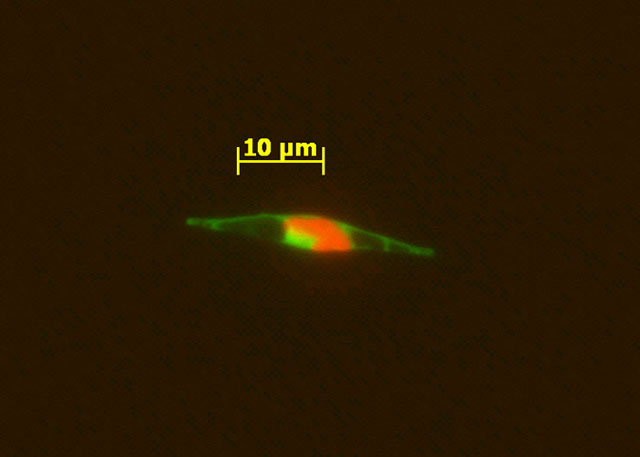Vitamin a dayScientists find marine algae possess protein capable of 'grabbing' B12Posted June 8, 2012
Scientists have revealed a key cog in the biochemical machinery that allows marine algae at the base of the oceanic food web to thrive. They have discovered a previously unknown protein in algae that grabs an essential but scarce nutrient out of seawater – vitamin B12. Many algae, as well as land-dwelling animals, including humans, require B12, but they cannot make it and must either acquire it from the environment or eat food that contains B12. Only certain single-celled bacteria and archaea have the ability to synthesize B12, which is also known as cobalamin. 
Photo Credit: Chris Dupont/J. Craig Venter Institute
An epifluorescence micrograph of a marine alga indicates that the cobalamin acquisition protein 1 (tagged with a light green fluorescent label) is associated with the outside of the cell wall, where it appears to facilitate bringing in vitamin B12 from the ocean into the cell. Red indicates cholorophyll.

Photo Credit: Erin Bertrand/Woods Hole Oceanographic Institution and J. Craig Venter Institute
Cobalamin acquistion protein 1 (CBA1) appears to operate by binding vitamin B12 in the ocean and bringing it into algal cells, where the vitamin is needed to create another enzyme essential for growth, methionine synthase (MetH).
Studying algal cultures and seawater samples from the Southern Ocean off Antarctica, a team of researchers from Woods Hole Oceanographic Institution (WHOI) The team reported their findings May 31 in Proceedings of the National Academy of Sciences. Erin Bertrand To discover CBA1, Bertrand and her advisor, WHOI biogeochemist Mak Saito Among thousands of other proteins present in the algae, or phytoplankton Discovery of CBA1 illuminates a small but vital piece of the fundamental metabolic machinery that allows phytoplankton to grow. The free-floating marine algae are a critical source of food for shrimplike krill and other zooplankton. They also play a key role in Earth’s climate, drawing huge amounts of carbon dioxide, a greenhouse gas, from the air via photosynthesis, incorporating carbon into their bodies. Some of the carbon ends up sinking to the ocean depths when phytoplankton die, effectively removing carbon from reentering the atmosphere for millennia. The discovery also opens the door for industrial or therapeutic applications. Since CBA1 is essential for phytoplankton growth, it could provide clues to how to promote growth of algae used to manufacture biofuels. Learning to manipulate the B12 biochemical pathways of beneficial or detrimental microbes could eventually lead to antibiotic or antifungal medicines. In addition to Saito, co-authors of the papers are Andrew Allen, Christopher Dupont, Trina Norden-Krichmar, Jing Bai and Ruben Valas of the Venter Institute. The research was funded by the National Science Foundation NSF-funded research in this story: Mak Saito, Woods Hole Oceanographic Institution, Award No. 0732665 |



For USAP Participants |
For The Public |
For Researchers and EducatorsContact UsNational Science FoundationOffice of Polar Programs Geosciences Directorate 2415 Eisenhower Avenue, Suite W7100 Alexandria, VA 22314 Sign up for the NSF Office of Polar Programs newsletter and events. Feedback Form |


